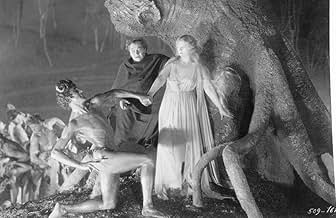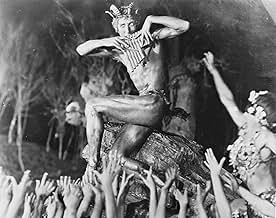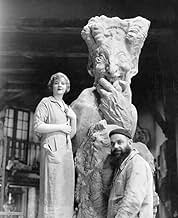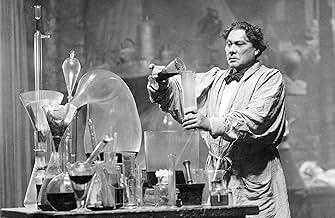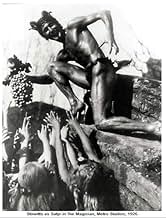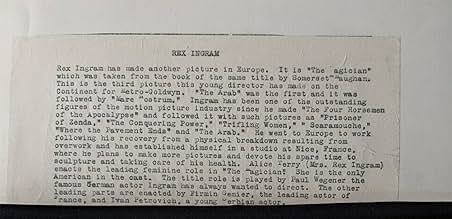A magician/alchemist, seeking to create life, finds that he needs the "blood of a virgin" to continue his experiments. He sends out his dwarf assistant to pick out the right girl.A magician/alchemist, seeking to create life, finds that he needs the "blood of a virgin" to continue his experiments. He sends out his dwarf assistant to pick out the right girl.A magician/alchemist, seeking to create life, finds that he needs the "blood of a virgin" to continue his experiments. He sends out his dwarf assistant to pick out the right girl.
Hubert I. Stowitts
- Dancing Faun
- (as Stowitts)
Claude Fielding
- Dancing Faun
- (uncredited)
Gerald Fielding
- Dancing Faun
- (uncredited)
Rosita Garcia
- Arab Girl Bitten by Snake
- (uncredited)
John George
- Haddo's Dwarf Servant
- (uncredited)
Michael Powell
- Man with Balloon at Snake Charming
- (uncredited)
- Director
- Writers
- All cast & crew
- Production, box office & more at IMDbPro
Featured reviews
In Paris, beautiful sculptress Alice Terry (as Margaret Dauncey) is critically wounded when a giant faun she is working on cracks, topples, and crushes her body. Ms. Terry's wealthy uncle summons American surgeon Ivan Petrovich (as Arthur Burdon) to operate on Terry's paralyzed body. The doctor and patient celebrate Terry's full recovery by falling in love. During their courtship, they encounter magician hypnotist Paul Wegener (as Oliver Haddo), an alchemist who witnessed Terry's miraculous surgery. A frightening, rotund man, Mr. Wegener happens to encounter Dr. Petrovich and Terry again and again. Wegener wants to create life, and has decided Terry will supply the "Blood of a Maiden" required in an ancient sorcerer's recipe!
While still a young woman, Terry seems more like a matron than a maiden - guess you just have to assume "The Magician" knows a virgin when he sees one. In W. Somerset Maugham's original novel, the Terry character is a teenaged art student, and the intriguing Gladys Hamer (as Susie Boyd) an older rival; it's an excellent read, and fairly easy to find on line (for free). Most unclear, in the film, is exactly how Wegener's experiment is supposed to work. Playing "Dr. Frankenstein" (and inspiring the 1931 classic's design), Wegener sets up a lab to extract blood, apparently. Highlighted by a hellish hallucination, it's very nicely envisioned by Terry's skillful director husband Rex Ingram; but, it lacks the richness of plot abundantly available in the book.
****** The Magician (10/24/26) Rex Ingram ~ Alice Terry, Paul Wegener, Ivan Petrovich, Firmin Gemier
While still a young woman, Terry seems more like a matron than a maiden - guess you just have to assume "The Magician" knows a virgin when he sees one. In W. Somerset Maugham's original novel, the Terry character is a teenaged art student, and the intriguing Gladys Hamer (as Susie Boyd) an older rival; it's an excellent read, and fairly easy to find on line (for free). Most unclear, in the film, is exactly how Wegener's experiment is supposed to work. Playing "Dr. Frankenstein" (and inspiring the 1931 classic's design), Wegener sets up a lab to extract blood, apparently. Highlighted by a hellish hallucination, it's very nicely envisioned by Terry's skillful director husband Rex Ingram; but, it lacks the richness of plot abundantly available in the book.
****** The Magician (10/24/26) Rex Ingram ~ Alice Terry, Paul Wegener, Ivan Petrovich, Firmin Gemier
Rex Ingram is probably best remembered for directing Rudolph Valentino's breakthrough film THE FOUIR HORSEMEN OF THE APOCALYPSE (1921) but he ventured into the fledgling terror genre with this thriller starring Paul (The Golem) Wegener.
Wegener's character, Dr. Oliver Haddo, is allegedly based on the real life character Alastair Crowley. When we first meet him he is in attendance as the famous Dr. Burdon (Ivan Petrovich) saves the life of lovely Margaret Dauncey (Alice Terry, the real life Mrs. Ingram) with an operation on her spine. While recovering, Margaret falls in love with Dr. Burdon and he returns her affections. Dr. Haddo is interested in her too but for far less healthy reasons. Dr. H you see, has been searching for the way to create artificial life in the laboratory (sound familiar?) and a old book on alchemy has informed him that he needs "the heart blood of a maiden" added to certain other chemicals to make this happen.
So determined is Haddo to make this happen that he hypnotises Margaret and marries her while she is under his spell. At his mountain top lab he plans to complete his diabolical experiment. Will Margaret lose her own life so Haddo can create life? Will Dr. Burdon find her in time? Ah . . . that would be telling!
What many of us wonder is, is Haddo a real magician or just a very good hypnotist? In one scene he allows a poisonous snake to bite him but makes the lethal wound vanish with just a wave of his hand. Just a moment later the same snake bites a young woman and she must be rushed to hospital. Now most of us know that a venomous snake expels all its venom at the first bite so the fact that it was the second bite that felled the woman should have been a tipoff that Haddo was not bitten at all. Yes, but remember this is a movie and we have to build up suspense. An amusing scene has Dr. Burdon and Dr. Haddo meeting for the first time in a park. As Haddo walks away Burdon remarks to Margaret "He looks like he stepped out of a melodrama!". As if on cue Haddo glares back, throws his cape over his shoulder and makes a perfect stage exit! It is an innocuous but effective moment and briefly clouds the menace that will soon be facing the lovers.
The sequence most people remember is where Haddo gives Margaret a look at Hell. It is a rugged looking place but rather removed from the horrors of the Italian film L'INFERNO (1909) or even DANTE'S INFERNO (1926). The place is loaded with damned souls but they all dance around carefree while Pan (at least I think it's Pan) plays a tune on his pipes. Another faun (dancer Hubert Stowitts) takes Margaret in his arms and passionately kisses her as the dream ends. So did they really go to Hell or was it all a hypnotic dream? In a key scene soon after this Haddo visits Margaret at her home and we clearly see his lips say the words "your rape" which sends her into the deepest despair. Whether the rape was actual or just implied quickly becomes a moot point because she goes away with him, convinced she can never marry Dr. Burdon now.
Elements of the final reels of THE MAGICIAN figure prominently in the Universal film FRANKENSTEIN (1931). Haddo has a monolithic castle at the top of a mountain, a dwarf assistant do you think his name is Fritz?) and a well equipped lab. I think that not only director James Whale but also the set designer for FRANKENSTEIN had to have sat through this film more than once.
Talkies came along about a year after this film was completed and Wegener, who was uncertain of his ability to speak English, returned to Germany. He was not alone, he was soon joined by Emil Jannings, Conrad Veidt and several other actors who had their doubts about being able to effectively perform in a foreign (to them)language.
So is THE MAGICIAN worth seeing? Yes it is, despite its shortcomings it is a well paced and convincingly performed thriller. Give it a try.
Wegener's character, Dr. Oliver Haddo, is allegedly based on the real life character Alastair Crowley. When we first meet him he is in attendance as the famous Dr. Burdon (Ivan Petrovich) saves the life of lovely Margaret Dauncey (Alice Terry, the real life Mrs. Ingram) with an operation on her spine. While recovering, Margaret falls in love with Dr. Burdon and he returns her affections. Dr. Haddo is interested in her too but for far less healthy reasons. Dr. H you see, has been searching for the way to create artificial life in the laboratory (sound familiar?) and a old book on alchemy has informed him that he needs "the heart blood of a maiden" added to certain other chemicals to make this happen.
So determined is Haddo to make this happen that he hypnotises Margaret and marries her while she is under his spell. At his mountain top lab he plans to complete his diabolical experiment. Will Margaret lose her own life so Haddo can create life? Will Dr. Burdon find her in time? Ah . . . that would be telling!
What many of us wonder is, is Haddo a real magician or just a very good hypnotist? In one scene he allows a poisonous snake to bite him but makes the lethal wound vanish with just a wave of his hand. Just a moment later the same snake bites a young woman and she must be rushed to hospital. Now most of us know that a venomous snake expels all its venom at the first bite so the fact that it was the second bite that felled the woman should have been a tipoff that Haddo was not bitten at all. Yes, but remember this is a movie and we have to build up suspense. An amusing scene has Dr. Burdon and Dr. Haddo meeting for the first time in a park. As Haddo walks away Burdon remarks to Margaret "He looks like he stepped out of a melodrama!". As if on cue Haddo glares back, throws his cape over his shoulder and makes a perfect stage exit! It is an innocuous but effective moment and briefly clouds the menace that will soon be facing the lovers.
The sequence most people remember is where Haddo gives Margaret a look at Hell. It is a rugged looking place but rather removed from the horrors of the Italian film L'INFERNO (1909) or even DANTE'S INFERNO (1926). The place is loaded with damned souls but they all dance around carefree while Pan (at least I think it's Pan) plays a tune on his pipes. Another faun (dancer Hubert Stowitts) takes Margaret in his arms and passionately kisses her as the dream ends. So did they really go to Hell or was it all a hypnotic dream? In a key scene soon after this Haddo visits Margaret at her home and we clearly see his lips say the words "your rape" which sends her into the deepest despair. Whether the rape was actual or just implied quickly becomes a moot point because she goes away with him, convinced she can never marry Dr. Burdon now.
Elements of the final reels of THE MAGICIAN figure prominently in the Universal film FRANKENSTEIN (1931). Haddo has a monolithic castle at the top of a mountain, a dwarf assistant do you think his name is Fritz?) and a well equipped lab. I think that not only director James Whale but also the set designer for FRANKENSTEIN had to have sat through this film more than once.
Talkies came along about a year after this film was completed and Wegener, who was uncertain of his ability to speak English, returned to Germany. He was not alone, he was soon joined by Emil Jannings, Conrad Veidt and several other actors who had their doubts about being able to effectively perform in a foreign (to them)language.
So is THE MAGICIAN worth seeing? Yes it is, despite its shortcomings it is a well paced and convincingly performed thriller. Give it a try.
Its all here in embryo: the paradigm for Frankenstein. The mad scientist, trying to create life in his laboratory located in a forbidden tower on the top of a rocky mountain, while thunder and lightning terrify the superstitious villagers. Supposedly adapted from a W. Somerset Maugham novel, the possibility exists that it was Maugham (a qualified physician) who, still very much on the make for an overwhelming success in his third book, might have cribbed more than a little bit from Mary Shelly. However, instead of the Romantic Prometheus, driven mad by hubris and symbolic of mankind's desire to harness newfangled science to dominate and conquer nature, despite the warnings of terrible consequences, all taking place on the edge of the Industrial revolution, we have the elements shaped into a Victorian melodrama of the villain-continued-to-pursue-her variety complete with virgin's blood and a heroine tied in artful knots, and a villain motivated by nothing more than criminal insanity.
On the other hand the artful visual qualities of the storytelling is something that has been lost in today's film vocabulary. A zippy 80 minutes or so, today the coarse need for thrills from this type of film would have necessitated a number anatomically gruesome murders before the final heroine jeopardy and heroic rescue. Here a little horror goes a very long way (all the way to the French Riviera, in fact). THE MAGICIAN is everything that made the silent film, at the same time, so great and so very silly. By the way, shots of Paris, virtually traffic free are a revelation, as are shots of a cobblestone village high up in the mountains (the Alps Maritimes) behind the Riviera. And yes, that's the same Paul Wegener who directed and starred in two versions of The Golom as well as playing Svengali in a 1927 version of the Du Maurier story.
On the other hand the artful visual qualities of the storytelling is something that has been lost in today's film vocabulary. A zippy 80 minutes or so, today the coarse need for thrills from this type of film would have necessitated a number anatomically gruesome murders before the final heroine jeopardy and heroic rescue. Here a little horror goes a very long way (all the way to the French Riviera, in fact). THE MAGICIAN is everything that made the silent film, at the same time, so great and so very silly. By the way, shots of Paris, virtually traffic free are a revelation, as are shots of a cobblestone village high up in the mountains (the Alps Maritimes) behind the Riviera. And yes, that's the same Paul Wegener who directed and starred in two versions of The Golom as well as playing Svengali in a 1927 version of the Du Maurier story.
In the 1920s films dealing with supernatural evil were extremely rare. However, director Rex Ingram, obviously influenced by earlier German forays into the supernatural, cast German actor Paul Wegener of DER GOLEM in this adaptation of Somerset Maugham's novel THE MAGICIAN. Wegener's menacing performance as an evil Yogi in LEBENDE BUDDHAS (1925) made him a good choice to play Oliver Haddo, obsessed with creating life from an ancient formula requiring the heart's blood of a maiden, played by Ingram's wife Alice Terry.
John F. Seitz' cinematography is superb, especially in the depiction of the heroine's hallucinatory descent into Hell where she is figuratively ravished by a lustful and athletic satyr. And although Haddo doesn't succeed in creating the grisly, half-complete humans as in the novel, the controversial subject matter was nevertheless strong enough to insure the film's failure at the box-office in 1926.
Interesting comparisons have been made between this film and James Wale's FRANKENSTEIN, but the subject of black magic also invites comparison with later films - THE BLACK CAT (1934), THE NIGHT OF THE DEMON (1957), and THE DEVIL RIDES OUT (1968) - featuring characters who like Oliver Haddo were modeled on real-life occultist Aleister Crowley.
John F. Seitz' cinematography is superb, especially in the depiction of the heroine's hallucinatory descent into Hell where she is figuratively ravished by a lustful and athletic satyr. And although Haddo doesn't succeed in creating the grisly, half-complete humans as in the novel, the controversial subject matter was nevertheless strong enough to insure the film's failure at the box-office in 1926.
Interesting comparisons have been made between this film and James Wale's FRANKENSTEIN, but the subject of black magic also invites comparison with later films - THE BLACK CAT (1934), THE NIGHT OF THE DEMON (1957), and THE DEVIL RIDES OUT (1968) - featuring characters who like Oliver Haddo were modeled on real-life occultist Aleister Crowley.
This is a very good silent film that still hold up very well today. When the film begins, Margaret (Alice Terry) is terribly injured--so badly she's paralyzed. However, Dr. Burdon (Iván Petrovich) performs surgery on her and she is healed. They soon fall in love and life looks grand. However, Oliver Haddo (Paul Wegener) sees her and instantly is smitten with her. Using his evil magical powers, he's able to pull her to him despite he loving the Doctor. However, he's not taking her because he loves her...nope. He's planning on using her for a human sacrifice in order to act like a Dr. Frankenstein and prove he can raise the dead!! Can Dr. Burdon rescue his love before it's too late?
This is a good film...very tense and exciting. Wegener (the German actor who starred in "The Golem") was excellent as the powerful madman and the film, though melodramatic, avoids going overboard like some films of the era thanks to good direction by Rex Ingram....Terry's real life husband.
This is a good film...very tense and exciting. Wegener (the German actor who starred in "The Golem") was excellent as the powerful madman and the film, though melodramatic, avoids going overboard like some films of the era thanks to good direction by Rex Ingram....Terry's real life husband.
Did you know
- TriviaThis movie, especially the explosion of the laboratory, influenced James Whale while making the Frankenstein (1931) movies.
- Quotes
Dr. Arthur Burdon: Your niece is certainly the most beautiful patient I have ever had.
Details
- Runtime
- 1h 23m(83 min)
- Sound mix
- Aspect ratio
- 1.33 : 1
Contribute to this page
Suggest an edit or add missing content

